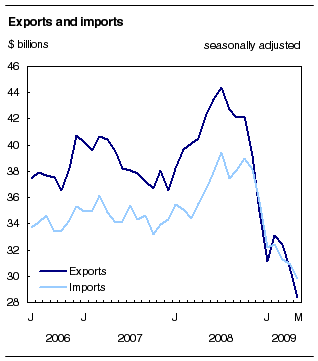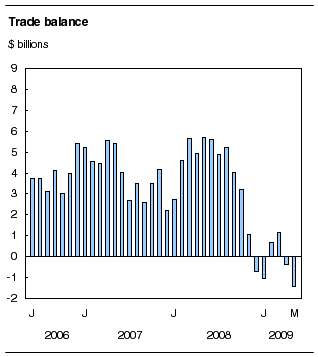Common menu bar links
Canadian international merchandise trade
Archived Content
Information identified as archived is provided for reference, research or recordkeeping purposes. It is not subject to the Government of Canada Web Standards and has not been altered or updated since it was archived. Please "contact us" to request a format other than those available.
Canada's merchandise exports fell 6.9% to $28.4 billion in May, as volumes declined 4.1% and prices decreased 2.9%. Imports were down 3.5% to $29.8 billion due to a 4.9% reduction in prices, while volumes rose 1.5%. As a result, Canada's trade deficit with the world widened to $1.4 billion in May from $389 million in April. The Canadian dollar appreciated 6.4% against the US dollar in May.

Exports and imports declined for the third consecutive month in May and have been trending downwards since July 2008. The declines observed in March, April and May 2009 were less pronounced than those at the end of 2008 and January 2009.
Since July 2008, export volumes have fallen by 23.7% and prices have declined by 16.2%. In comparison, import volumes have fallen by 24.5% while prices have edged down 0.1% during the same period.
Although the declines were widespread across all sectors in May, the continued weakness in global demand for energy products and the restructuring of the automotive industry accounted for more than half of the decrease in exports and imports.
Exports to the United States fell 8.1% to $20.3 billion, largely the result of lower exports of automotive products and crude petroleum, which have been affected by the economic downturn in the United States. Imports decreased 3.3% to $18.8 billion. Consequently, Canada's trade surplus with the United States shrank to $1.5 billion in May from $2.6 billion in April.
Note to readers
Merchandise trade is one component of Canada's international balance of payments, which also includes trade in services, investment income, current transfers as well as capital and financial flows.
International merchandise trade data by country are available on both a balance of payments and a customs basis for the United States, Japan and the United Kingdom. Trade data for all other individual countries are available on a customs basis only. Balance of payments data are derived from customs data by making adjustments for characteristics such as valuation, coverage, timing and residency. These adjustments are made to conform to the concepts and definitions of the Canadian System of National Accounts.
Constant dollars referred to in the text are calculated using the Laspeyres volume formula.
In general, merchandise trade data are revised on an ongoing basis for each month of the current year. Current year revisions are reflected in both the customs and balance of payments based data. Revisions to customs based data for the previous year are released on a quarterly basis. Revisions to balance of payments based data for the three previous years are released annually in June.
Factors influencing revisions include late receipt of import and export documentation, incorrect information on customs forms, replacement of estimates with actual figures, changes in classification of merchandise based on more current information, and changes to seasonal adjustment factors.
Revised data are available in the appropriate CANSIM tables.
Canada's trade deficit with countries other than the United States narrowed to $2.9 billion in May from $3.0 billion in April. Exports and imports both fell by 3.7%.

Energy products and automotive products lead the decline in exports
All export sectors declined, with the largest movements observed in energy products and automotive products.
Energy products fell 10.6% to $5.4 billion, mainly due to a combination of volume and price reductions, with volumes being the dominant factor. Lower exports of natural gas and crude petroleum were largely responsible for the decline, as global demand for these products remained weak.
Exports of automotive products fell 12.4% to $3.0 billion, largely the result of volume reductions. Exports of trucks declined 33.0% as the production of some large pick-up trucks was halted in May. Exports of passenger autos and motor vehicle parts decreased 7.6% and 11.2% respectively, as a result of restructuring in the North American automotive industry.
The agricultural and fishing sector declined 8.7% to $3.2 billion, mostly due to reduced volumes. Canola and wheat, which had driven the increase in April, accounted for most of the decline in May.
Exports of industrial goods and materials decreased 4.9% to $6.0 billion, the third consecutive decline. Although the decreases were generalized, lower exports of precious metals accounted for more than half of the decline in this sector.
Imports down across the board
All imports sectors declined, led by the automotive products, energy products, and machinery and equipment sectors.
The modest gains observed in automotive products from January to April were completely erased by the drop in imports in May, as the restructuring of the automotive industry continued. Imports of automotive products fell 7.3% to $3.8 billion, the lowest level since March 1996. Lower imports of motor vehicle parts were the main contributor to the decrease, falling 10.6%. Passenger autos and trucks also declined.
Imports of energy products fell 10.7% to $2.3 billion due to a combination of volume and price decreases. This decline was entirely the result of a 21.7% decrease in crude petroleum volume.
Imports of machinery and equipment slid by 2.7% to $9.0 billion, as prices declined and volumes rose. Lower imports of aircraft accounted for more than three-quarters of the drop in this sector. Imports of engines, turbines and motors, up 54.6%, mitigated the decrease.
Available on CANSIM: tables 228-0001 to 228-0003, 228-0033, 228-0034, 228-0041 to 228-0043 and 228-0047 to 228-0057.
Definitions, data sources and methods: survey numbers, including related surveys, 2201, 2202 and 2203.
The May 2009 issue of Canadian International Merchandise Trade, Vol. 63, no. 5 (65-001-X, free), is now available from the Publications module of our website.
Current account data (which incorporate merchandise trade statistics, service transactions, investment income and transfers) are available quarterly in Canada's Balance of International Payments (67-001-X, free).
For more information, contact Sharon Nevins (toll-free 1-800-294-5583; 613-951-9798). To enquire about the concepts, methods or data quality of this release, contact Mychèle Gagnon (613-951-0994), International Trade Division.
Table 1
| April 2009r | May 2009 | April to May 2009 | May 2008 to May 2009 | |
|---|---|---|---|---|
| Seasonally adjusted, $ current | ||||
| $ millions | % change | |||
| Principal trading partners | ||||
| Exports | ||||
| United States | 22,053 | 20,263 | -8.1 | -35.7 |
| Japan | 783 | 630 | -19.5 | -43.4 |
| European Union1 | 2,668 | 2,490 | -6.7 | -25.0 |
| Other OECD countries2 | 1,401 | 1,390 | -0.8 | -30.0 |
| All other countries | 3,569 | 3,600 | 0.9 | -18.5 |
| Total | 30,475 | 28,372 | -6.9 | -33.0 |
| Imports | ||||
| United States | 19,434 | 18,785 | -3.3 | -19.6 |
| Japan | 743 | 710 | -4.4 | -24.0 |
| European Union1 | 3,327 | 3,215 | -3.4 | -15.8 |
| Other OECD countries2 | 1,973 | 1,820 | -7.8 | -19.9 |
| All other countries | 5,387 | 5,263 | -2.3 | -16.5 |
| Total | 30,864 | 29,793 | -3.5 | -18.8 |
| Balance | ||||
| United States | 2,619 | 1,478 | ... | ... |
| Japan | 40 | -80 | ... | ... |
| European Union1 | -659 | -725 | ... | ... |
| Other OECD countries2 | -572 | -430 | ... | ... |
| All other countries | -1,818 | -1,663 | ... | ... |
| Total | -389 | -1,421 | ... | ... |
| Principal commodity groupings | ||||
| Exports | ||||
| Agricultural and fishing products | 3,546 | 3,238 | -8.7 | -8.2 |
| Energy products | 6,028 | 5,388 | -10.6 | -53.7 |
| Forestry products | 1,635 | 1,580 | -3.4 | -27.4 |
| Industrial goods and materials | 6,264 | 5,960 | -4.9 | -38.7 |
| Machinery and equipment | 7,002 | 6,721 | -4.0 | -13.4 |
| Automotive products | 3,436 | 3,009 | -12.4 | -38.0 |
| Other consumer goods | 1,569 | 1,567 | -0.1 | 6.1 |
| Special transactions trade3 | 539 | 517 | -4.1 | -23.7 |
| Other balance of payments adjustments | 454 | 391 | -13.9 | -26.2 |
| Imports | ||||
| Agricultural and fishing products | 2,498 | 2,435 | -2.5 | 4.8 |
| Energy products | 2,629 | 2,348 | -10.7 | -44.3 |
| Forestry products | 202 | 183 | -9.4 | -24.7 |
| Industrial goods and materials | 6,095 | 6,004 | -1.5 | -23.5 |
| Machinery and equipment | 9,300 | 9,045 | -2.7 | -11.8 |
| Automotive products | 4,146 | 3,844 | -7.3 | -34.7 |
| Other consumer goods | 4,951 | 4,807 | -2.9 | 3.2 |
| Special transactions trade3 | 374 | 456 | 21.9 | -12.3 |
| Other balance of payments adjustments | 670 | 672 | 0.3 | -8.9 |

